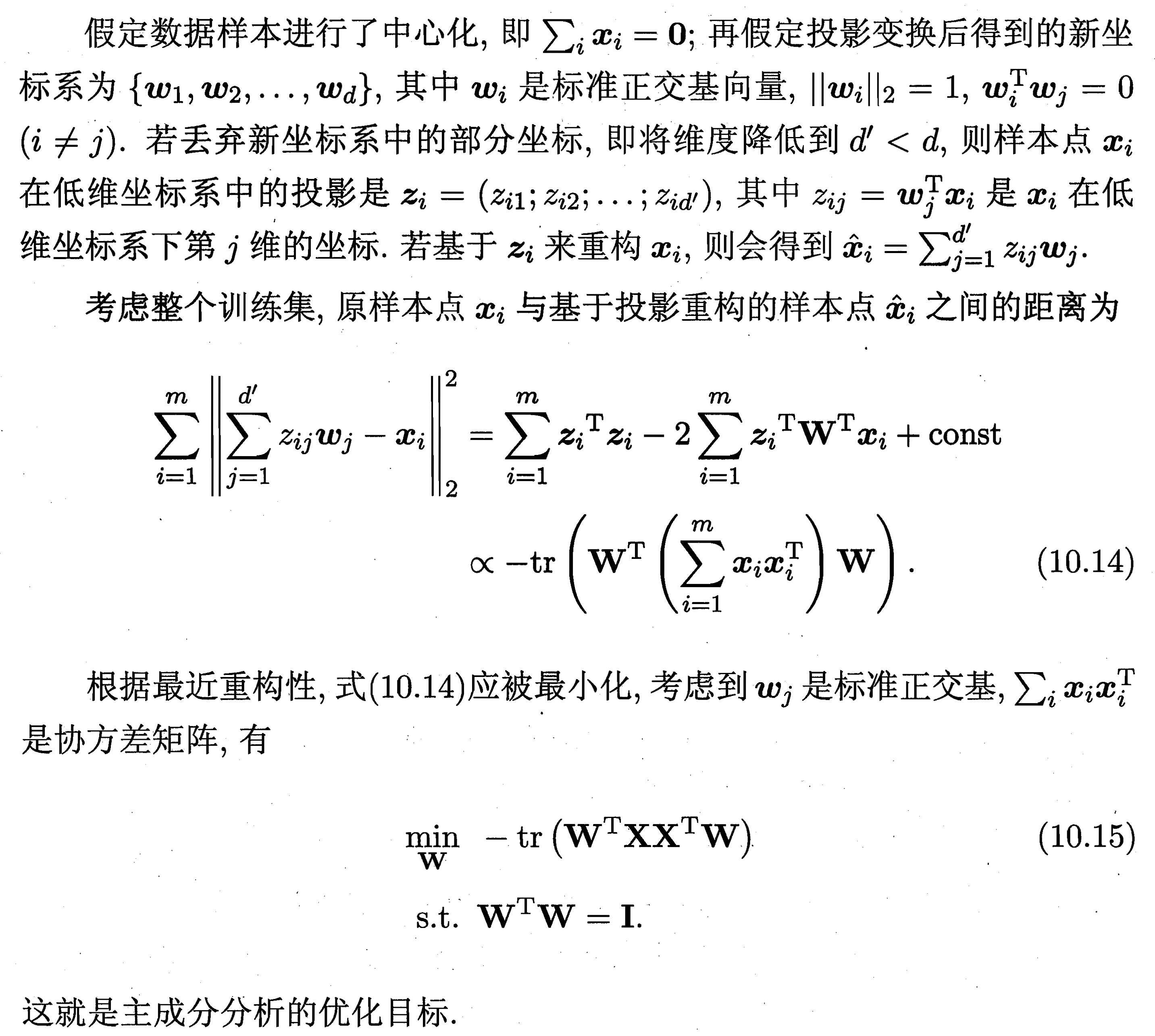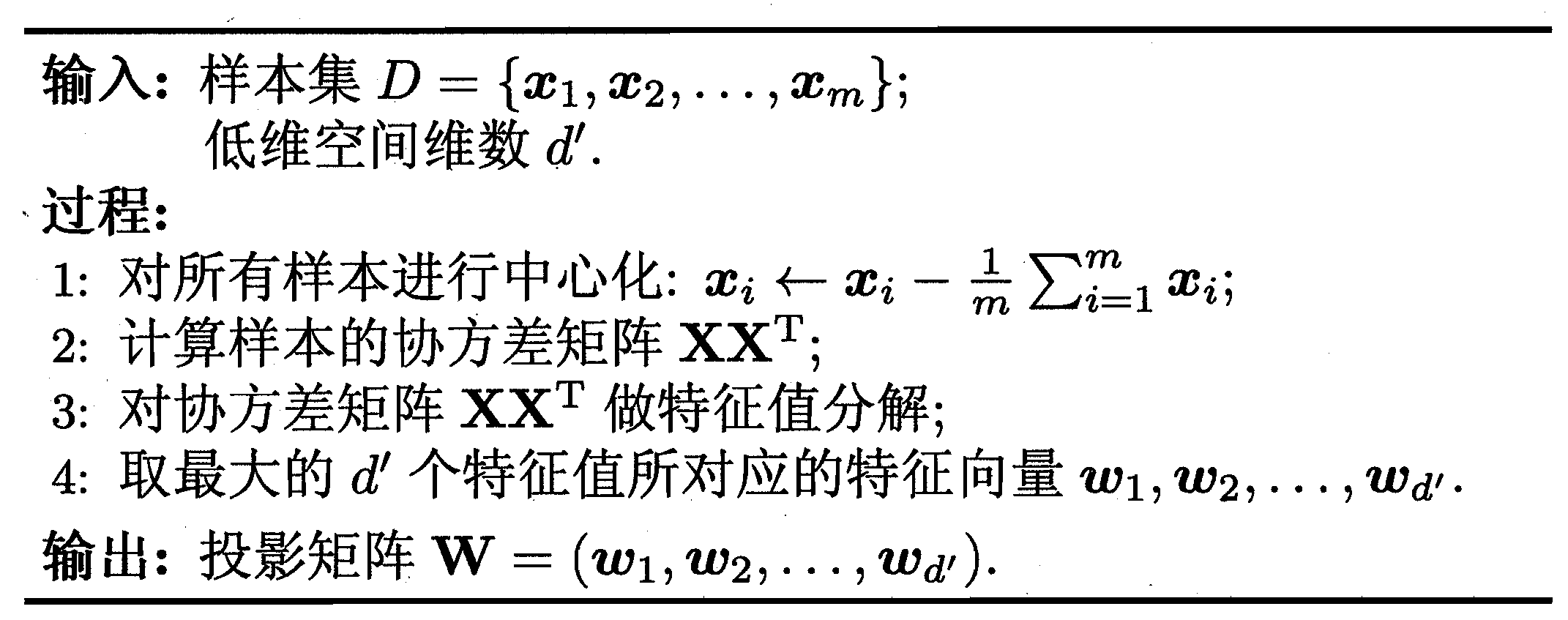MATLAB实例:PCA(主成成分分析)详解
作者:凯鲁嘎吉 - 博客园 http://www.cnblogs.com/kailugaji/
1. 主成成分分析






2. MATLAB解释
详细信息请看:Principal component analysis of raw data - mathworks
[coeff,score,latent,tsquared,explained,mu] = pca(X)
coeff = pca(X) returns the principal component coefficients, also known as loadings, for the n-by-p data matrix X. Rows of X correspond to observations and columns correspond to variables.
The coefficient matrix is p-by-p.
Each column of coeff contains coefficients for one principal component, and the columns are in descending order of component variance.
By default, pca centers the data and uses the singular value decomposition (SVD) algorithm.
coeff = pca(X,Name,Value) returns any of the output arguments in the previous syntaxes using additional options for computation and handling of special data types, specified by one or more Name,Value pair arguments.
For example, you can specify the number of principal components pca returns or an algorithm other than SVD to use.
[coeff,score,latent] = pca(___) also returns the principal component scores in score and the principal component variances in latent.
You can use any of the input arguments in the previous syntaxes.
Principal component scores are the representations of X in the principal component space. Rows of score correspond to observations, and columns correspond to components.
The principal component variances are the eigenvalues of the covariance matrix of X.
[coeff,score,latent,tsquared] = pca(___) also returns the Hotelling's T-squared statistic for each observation in X.
[coeff,score,latent,tsquared,explained,mu] = pca(___) also returns explained, the percentage of the total variance explained by each principal component and mu, the estimated mean of each variable in X.
coeff: X矩阵所对应的协方差矩阵的所有特征向量组成的矩阵,即变换矩阵或投影矩阵,coeff每列代表一个特征值所对应的特征向量,列的排列方式对应着特征值从大到小排序。
source: 表示原数据在各主成分向量上的投影。但注意:是原数据经过中心化后在主成分向量上的投影。
latent: 是一个列向量,主成分方差,也就是各特征向量对应的特征值,按照从大到小进行排列。
tsquared: X中每个观察值的Hotelling的T平方统计量。Hotelling的T平方统计量(T-Squared Statistic)是每个观察值的标准化分数的平方和,以列向量的形式返回。
explained: 由每个主成分解释的总方差的百分比,每一个主成分所贡献的比例。explained = 100*latent/sum(latent)。
mu: 每个变量X的估计平均值。
3. MATLAB程序
3.1 方法一:指定降维后低维空间的维度k
1 2 3 4 5 6 7 8 9 10 11 12 13 | function [data_PCA, COEFF, sum_explained]=pca_demo_1(data,k)% k:前k个主成分data=zscore(data); %归一化数据[COEFF,SCORE,latent,tsquared,explained,mu]=pca(data);latent1=100*latent/sum(latent);%将latent特征值总和统一为100,便于观察贡献率data= bsxfun(@minus,data,mean(data,1));data_PCA=data*COEFF(:,1:k);pareto(latent1);%调用matla画图 pareto仅绘制累积分布的前95%,因此y中的部分元素并未显示xlabel('Principal Component');ylabel('Variance Explained (%)');% 图中的线表示的累积变量解释程度print(gcf,'-dpng','PCA.png');sum_explained=sum(explained(1:k)); |
3.2 方法二:指定贡献率percent_threshold
1 2 3 4 5 6 7 8 9 10 11 12 13 14 15 16 17 18 19 20 21 22 | function [data_PCA, COEFF, sum_explained, n]=pca_demo_2(data)%用percent_threshold决定保留xx%的贡献率percent_threshold=95; %百分比阈值,用于决定保留的主成分个数;data=zscore(data); %归一化数据[COEFF,SCORE,latent,tsquared,explained,mu]=pca(data);latent1=100*latent/sum(latent);%将latent特征值总和统一为100,便于观察贡献率A=length(latent1);percents=0; %累积百分比for n=1:A percents=percents+latent1(n); if percents>percent_threshold break; endenddata= bsxfun(@minus,data,mean(data,1));data_PCA=data*COEFF(:,1:n);pareto(latent1);%调用matla画图 pareto仅绘制累积分布的前95%,因此y中的部分元素并未显示xlabel('Principal Component');ylabel('Variance Explained (%)');% 图中的线表示的累积变量解释程度print(gcf,'-dpng','PCA.png');sum_explained=sum(explained(1:n)); |
4. 结果
数据来源于MATLAB自带的数据集hald
1 2 3 4 5 6 7 8 9 10 11 12 13 14 15 16 17 18 19 20 21 22 23 24 25 26 27 28 29 30 31 32 33 34 35 36 37 38 39 40 41 42 43 44 45 46 47 48 49 50 51 52 53 54 55 56 57 58 59 60 61 62 63 64 65 66 67 | >> load hald>> [data_PCA, COEFF, sum_explained]=pca_demo_1(ingredients,2)data_PCA = -1.467237802258083 -1.903035708425560 -2.135828746398875 -0.238353702721984 1.129870473833422 -0.183877154192583 -0.659895489750766 -1.576774209965747 0.358764556470351 -0.483537878558994 0.966639639692207 -0.169944028103651 0.930705117077330 2.134816511997477 -2.232137996884836 0.691670682875924 -0.351515595975561 1.432245069443404 1.662543014130206 -1.828096643220118 -1.640179952926685 1.295112751426928 1.692594091826333 0.392248821530480 1.745678691164958 0.437525487914425COEFF = 0.475955172748970 -0.508979384806410 0.675500187964285 0.241052184051094 0.563870242191994 0.413931487136985 -0.314420442819292 0.641756074427213 -0.394066533909303 0.604969078471439 0.637691091806566 0.268466110294533 -0.547931191260863 -0.451235109330016 -0.195420962611708 0.676734019481284sum_explained = 95.294252628439153>> [data_PCA, COEFF, sum_explained, n]=pca_demo_2(ingredients)data_PCA = -1.467237802258083 -1.903035708425560 -2.135828746398875 -0.238353702721984 1.129870473833422 -0.183877154192583 -0.659895489750766 -1.576774209965747 0.358764556470351 -0.483537878558994 0.966639639692207 -0.169944028103651 0.930705117077330 2.134816511997477 -2.232137996884836 0.691670682875924 -0.351515595975561 1.432245069443404 1.662543014130206 -1.828096643220118 -1.640179952926685 1.295112751426928 1.692594091826333 0.392248821530480 1.745678691164958 0.437525487914425COEFF = 0.475955172748970 -0.508979384806410 0.675500187964285 0.241052184051094 0.563870242191994 0.413931487136985 -0.314420442819292 0.641756074427213 -0.394066533909303 0.604969078471439 0.637691091806566 0.268466110294533 -0.547931191260863 -0.451235109330016 -0.195420962611708 0.676734019481284sum_explained = 95.294252628439153n = 2 |

5. 参考
[1] 周志华,《机器学习》.
[2] MATLAB实例:PCA降维



【推荐】国内首个AI IDE,深度理解中文开发场景,立即下载体验Trae
【推荐】编程新体验,更懂你的AI,立即体验豆包MarsCode编程助手
【推荐】抖音旗下AI助手豆包,你的智能百科全书,全免费不限次数
【推荐】轻量又高性能的 SSH 工具 IShell:AI 加持,快人一步
· 10年+ .NET Coder 心语,封装的思维:从隐藏、稳定开始理解其本质意义
· .NET Core 中如何实现缓存的预热?
· 从 HTTP 原因短语缺失研究 HTTP/2 和 HTTP/3 的设计差异
· AI与.NET技术实操系列:向量存储与相似性搜索在 .NET 中的实现
· 基于Microsoft.Extensions.AI核心库实现RAG应用
· 10年+ .NET Coder 心语 ── 封装的思维:从隐藏、稳定开始理解其本质意义
· 地球OL攻略 —— 某应届生求职总结
· 提示词工程——AI应用必不可少的技术
· Open-Sora 2.0 重磅开源!
· 字符编码:从基础到乱码解决